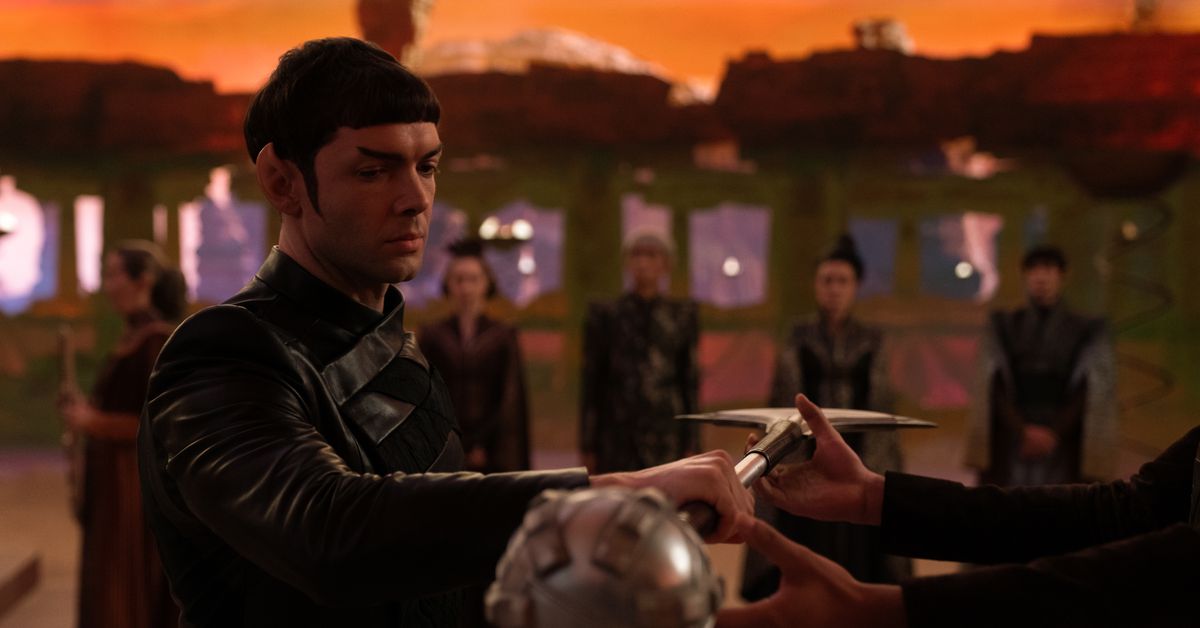
In the age of thunderingly loud blockbusters and hyper-serial prestige television, Star Trek has struggled. The J.J. Abrams films tried to reinvent Star Trek for the mega action film era, and Star Trek: Discovery tried to reinvent it for serial TV. And others, like Picard and Lower Decks, have just tried to play to the fans with intense nostalgia and in-jokes. They’ve all been Star Trek, but they haven’t had quite the same impact as the original series or the Star Trek series of the ‘90s. Watching Star Trek: Strange New Worlds feels like watching The Next Generation or Voyager or even The Original Series. It’s Star Trek updated pitch perfectly for 2022, and that’s in large part because it knows what we want: filler episodes.
The franchise is enormous at this point — as big as Star Wars or Doctor Who, but it often feels like it has been at odds with itself and kind of embarrassed by its own existence in a way those other franchises aren’t. It’s like a petulant teenager who really wants to go trick or treating with the family but doesn’t want to run into any friends in case they get made fun of.
Strange New Worlds isn’t like that. This show understands that you can be earnest and you can be goofy and you can still tell really good and entertaining stories. It’s not embarrassed to exist. And, yes, a lot of that is down to a terrific cast — helmed by Anson Mount as Christopher Pike and Rebecca Romijn as his second in command, Una Chin-Riley (or Number One if you’re familiar with the original Star Trek show). But beyond a great cast appearing in a great-looking show, what’s really captivated me is how Strange New Worlds is happy to embrace the filler episode.
Filler episodes are defined as the ones not pertaining to the overarching stories in a series. They’re often episodes about downtime, or they’re the weird, funny episode in a typically dramatic show. They exist because, until streaming caught on, most TV series had 20-plus episode orders. In the same amount of time many series now turn out six to 10 episodes, writer’s rooms would typically have to turn out something closer to 22 scripts. That meant things could get weird. A lot of those 20 episodes could have serial plots: Mulder and Scully and their war against the Cigarette Smoking Man and the Consortium or the myriad “beloved doctor gets sick” plotlines on ER. But the shows would also have episodes that got experimental or silly or just plain content to not raise the stakes to “the end of the world as we know it.” Part of the reason Picard getting Borg-ified had so much impact on Star Trek: The Next Generation was because we knew this was also the nerd who liked to play a private eye on the holodeck.
As short episode orders and highly serialized plotlines became the du jour in TV, the filler episode fell out of fashion. The cast of Star Trek: Discovery is not accidentally acting out a fairy tale for the amusement of a fourth-dimensional being anytime soon. But I’d argue that the filler episode was also what distinguished TV from movies as an art form. Highly serialized shows like Obi-Wan Kenobi airing on Disney Plus feel like films, carefully partitioned out over several weeks. One of the biggest complaints about many new shows on Netflix is that they feel like overlong movies. The plot is always hustling, and we never have time to just sit with a character and get to know them.
And the appeal of TV for so long — the reason it often inspires enormous online fandoms — is because you spend so much time with these characters that you know them better than the ones you spend two hours in a theater with.
Six episodes in, Strange New Worlds hasn’t been afraid to take a breath and let us just enjoy these characters — just like Trek fans used to do with previous series. So we can have an episode where Captain Pike, who learned his own tragic future on Star Trek: Discovery, tries to come to terms with it, and we can have an episode that makes the supremely goofy Gorn Kirk once wrestled a legitimately spooky threat. But we can also have an episode where everyone enjoys their day off and two characters accidentally switch bodies and negotiate some diplomatic treaties.
The show is comfortable developing the characters in a wide variety of ways while not feeling the need to always check in on some looming threat. Shows like Stranger Things could learn a lot from the more gentle plotting. Sometimes we don’t need seven episodes racing toward the end of the world. Sometimes we just need one or two — you know, so we can have time for that body-switching or “Groundhog Day” episode.
Star Trek: Strange New Worlds airs new episodes every Thursday on Paramount Plus.



/cdn.vox-cdn.com/uploads/chorus_asset/file/25547226/1242875577.jpg)
/cdn.vox-cdn.com/uploads/chorus_asset/file/25546751/ES601_WEBR_GalleryImages_KitchenCounterLineUp_2048x2048.jpg)

